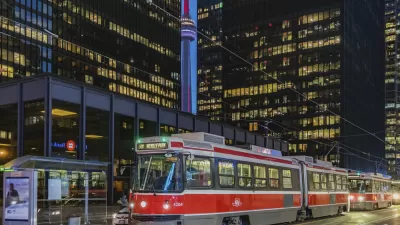The Toronto Transit Commission (TTC) is considering switching its single-trip transfer system to a more flexible time-based system allowing short return trips to be made without paying twice. Low-income and marginalized riders stand to benefit most.
Hearing the appeal of its riders, the TTC is investigating the possibility of switching to a time-based transfer system which would allow riders to re-enter the system travelling in any direction within either a 90 or 120 minute transfer window. The current system permits only one-way continuous trips and prohibits backtracking.
The time-based system - already the standard in many North American cities - would allow riders to make quick errands on a single fare but as Ben Spurr writes, “the new transfers’ most important effect would be to make public transit more equitable, by providing fare relief to the vulnerable groups who rely on the TTC the most.”
“In Toronto (as elsewhere) low-income earners are the biggest users of public transit. According to a 2010 study, 56 per cent of households earning less than $24,000 a year did not own a car, compared to 29 per cent of households making $40,000 or more.”
Transit users in Toronto are also disproportionately female (58.2%). Dr. Kara Santokie, project director for the Toronto Women’s City Alliance says “’timed transfers would ease the burden on low-income women, who are disproportionately new immigrants or from racialized groups, by allowing them to make round trips on a single fare. That’s especially important as fares continue to rise year after year.’”
Scrapping single-trip transfers would also relieve bus and streetcar operators the onerous duty of enforcing the system. The TTC estimated the switch would cost $20 million annually in lost revenue.
FULL STORY: How timed transfers would help the TTC’s most vulnerable riders

Alabama: Trump Terminates Settlements for Black Communities Harmed By Raw Sewage
Trump deemed the landmark civil rights agreement “illegal DEI and environmental justice policy.”

Study: Maui’s Plan to Convert Vacation Rentals to Long-Term Housing Could Cause Nearly $1 Billion Economic Loss
The plan would reduce visitor accommodation by 25% resulting in 1,900 jobs lost.

Why Should We Subsidize Public Transportation?
Many public transit agencies face financial stress due to rising costs, declining fare revenue, and declining subsidies. Transit advocates must provide a strong business case for increasing public transit funding.

Paris Bike Boom Leads to Steep Drop in Air Pollution
The French city’s air quality has improved dramatically in the past 20 years, coinciding with a growth in cycling.

Why Housing Costs More to Build in California Than in Texas
Hard costs like labor and materials combined with ‘soft’ costs such as permitting make building in the San Francisco Bay Area almost three times as costly as in Texas cities.

San Diego County Sees a Rise in Urban Coyotes
San Diego County experiences a rise in urban coyotes, as sightings become prevalent throughout its urban neighbourhoods and surrounding areas.
Urban Design for Planners 1: Software Tools
This six-course series explores essential urban design concepts using open source software and equips planners with the tools they need to participate fully in the urban design process.
Planning for Universal Design
Learn the tools for implementing Universal Design in planning regulations.
Smith Gee Studio
Alamo Area Metropolitan Planning Organization
City of Santa Clarita
Institute for Housing and Urban Development Studies (IHS)
City of Grandview
Harvard GSD Executive Education
Toledo-Lucas County Plan Commissions
Salt Lake City
NYU Wagner Graduate School of Public Service





























